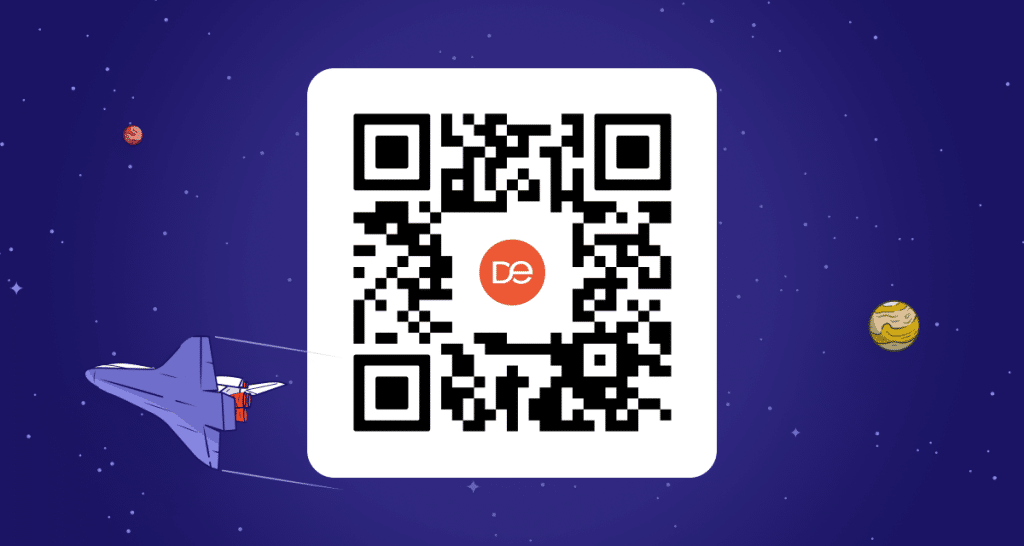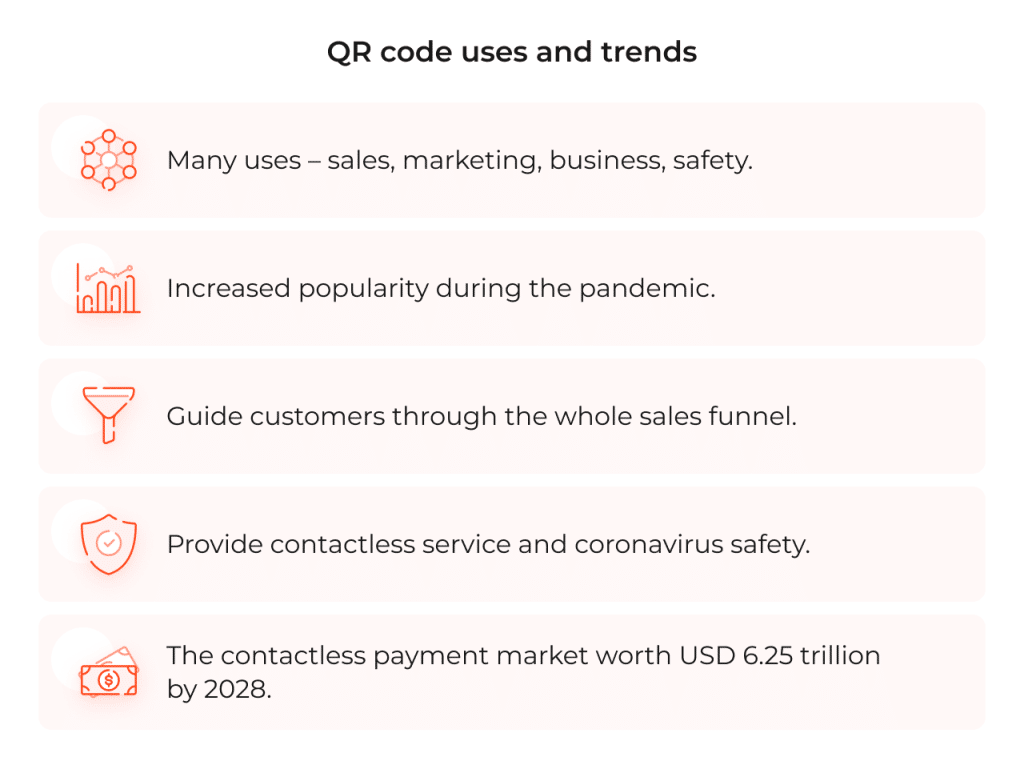QR codes aren’t going anywhere. Here’s what you can use them for

QR codes have become highly popular since their introduction to the market in 1994. They started as simple information carriers for production, shipping, and transaction activities in the automotive industry. Due to their versatility, QR codes quickly spread to other sectors, and now you can use them for many reasons – from ads through payments to saving lives! The popularity of QR codes has been changing over time, but their usability is growing rapidly in the pandemic world. And since so many businesses can benefit from this solution, why not join them? Explore our article and learn how QR codes work and how to use QR codes to boost your business activities.
What is a QR code?
You have probably seen many QR codes around you (even in this article!). But for the sake of clarity, let’s explain what a QR code is. The term „QR” stands for Quick Response. The code itself usually is a square barcode that stores specific information allowing you to access websites, applications, images, or other media. You need a QR code scanner to decode the encrypted data. Many devices come with pre-installed scanners, but you can also download a free QR code app. Thanks to the square shape and position detectors, the QR code works regardless of how you scan it.
How it started – a brief QR code history
QR codes were created in Japan as direct descendants of barcodes developed in the US in the 1950s. Japanese supermarkets started using barcodes in the 1960s to automate the checkout process. Earlier cashiers had to manually input each product leading to a great workload and occupational diseases such as carpal tunnel syndrome.
Unfortunately, barcodes stored very little information (up to 20 characters) and could be scanned only in one direction. The need for an „improved barcode” sparked the creation of the first QR code in 1994. Prompted by its customers, the Japanese company DENSO WAVE developed a two-dimensional barcode that stored over 7000 numeric characters and worked 10 times faster than the traditional barcode.
QR codes quickly caught on in the business environment, but it took over a decade for regular consumers to follow that trend. The rapid growth in QR code popularity coincided with the introduction of smartphones to the market. Consider these QR code statistics:
- QR code use in the USA increased by 4,549% between Q1 2010 and Q1 2011
- over 20 million QR code scans were performed in the USA in the period July-October 2011
- 26-29% of citizens of four developed countries (Germany, France, Great Britain, and the USA) were using QR codes in 2014
- several large companies (Vodafone, Mercedes, and Shell in the UK, WeChat in China, Walmart, and Target in the USA) started implementing QR code payment in 2015
Since then, the QR code trend slowly increased until it peaked twice at the end of 2019 and 2020. This resulted from respectively a growing interest in modern technologies and the COVID-19 pandemic. The latter changed the approach to all forms of communication. The boom of contactless payment and services made businesses discover new QR code benefits. We also see great potential in them. That is why and we would like to share a few good ideas on how QR codes can work for your business, sales, and marketing activities as well as in terms of safety issues.
QR codes in modern business
QR codes in sales
Whatever products you are selling, you can always use QR codes in your catalog to quickly bring your customers to a dedicated product page. Another good idea is to place a QR code directly on the product to help your customers learn more about it. QR codes are also a great way for placing orders, contactless payment, or claiming coupons. There are many systems on the market that you can use to implement QR codes into your transactions.
The COVID-19 pandemic has fostered the use of QR code POS systems, thus reducing human interaction. QR codes can even help you with aftersales service – just encourage your customers to leave a review or comment by scanning a QR code. The faster your customers can finalize their transactions, the more likely they are to buy from you in the future.
QR codes in marketing
You can already find numerous examples of QR code marketing or advertising, and new ideas are born almost every minute. Let’s have a look at them. Firstly, think about the places where you can put a QR code. The options include posters, leaflets, various gadgets, packages, clothes, furniture – practically any flat and accessible area of 2 cm2 (0.31 in2). The best idea is to match the QR code placement with its content to form a logical sequence, e.g., a QR code at the airport leading you to taxi services.
Now, let’s focus on the QR code content. QR codes can successfully guide your customers through all stages of the sales funnel. For instance, you can lead them to newsletter signups, online catalogs/menus, coupons, tutorials and infographics, your social media, digital product samples, and free app trials. Thanks to their versatility and ease of use, QR codes are a great way to bring your customers to you and win them over. Get some inspiration for your QR code marketing campaign here.
QR codes in business communication
Doing business has never been faster. That is why businesspeople appreciate any form of contact that saves their time and effort. For starters, a QR code on a business card is practically a must-have. Your business partners can use it to get your contact details, view your website/résumé or even schedule an appointment with you.
Business communication often involves many documents. You can score extra points if you include a QR code on paper documents leading to their electronic versions or some other documents. No more searching through e-mail inboxes for long-lost files – your partners retrieve them with a QR code. The use of QR codes will speed up your work and make you look professional in your partners’ eyes.
QR codes for safety
Apart from QR code payments, QR codes can help you keep other activities safe. You can use a QR code authenticator to grant your users easy access to their accounts. You can also place QR codes on tickets to speed up your visitor queues and prevent any unauthorized persons from entering (everyone gets a personalized code).
We also need to mention coronavirus safety here. QR codes can easily limit the spread of SARS-CoV-2. Smartphone users can simply scan a QR code with their device or on their device to achieve the desired result. No surface touching or human interaction is needed. That is why you should implement QR codes to ensure coronavirus safety and show that your company cares about its customers.
Non-standard QR code uses
QR codes open entirely new dimensions for creativity in business and non-business areas. Some ideas can seem crazy (like a rickroll QR code tattoo) while others can literally save lives. For instance, in April this year in Shanghai, a swarm of drones formed a giant QR code to promote a role-playing game Princess Connect! Re:Dive. Speaking of games, QR codes are also a brilliant tool for scavenger hunt games that can be played across entire cities. Another interesting use: some funeral homes carve QR codes into tombstones – you can use them to learn about the deceased person’s life.
On the other hand, QR codes help with saving senior citizens. BBC states that the city council of Iruma, Japan, introduced the idea of placing QR codes on the fingernails of elderly people with dementia. The QR code can last up to two weeks and allows to contact the families of senior citizens who wandered off home and got lost. The idea was a direct response to the problem of missing family members. The Guardian states that Japan reported 12,000 dementia patients missing in 2015. Placing QR codes on their fingernails will greatly facilitate police work. We could say poetically that QR codes are with you through life and death.
The future of QR codes
QR codes are gaining popularity in the pandemic era, but are they really here to stay? Let’s have a look at scientific reports:
- 1 billion smartphones will have access to QR codes while 5.3 billion QR code coupons will be claimed via smartphones by 2022
- The contactless payment market is predicted to reach USD 6.25 trillion – CAGR of 20.3% – by 2028
- 80% of activities related to orders, checking out and payments will be contactless by 2024 – an opportunity for QR code payments
These predictions prove that QR codes really aren’t going anywhere. As technology advances, QR codes are likely to be developed rather than being replaced by more advanced solutions. So, if you haven’t implemented them into your business yet, now is the best time. If you are already using them, try out our tips and make your business activities quick, easy, and contactless. The possibilities – just like outer space itself – are practically endless.
We hope that you can get the best out of QR codes. If you have any creative ideas for using them or you are looking for other ways to make your company more efficient, check our website or read more:




